New process for manufacturing PV cells means cheaper solar power
A major roadblock to the mass use of solar energy are photovoltaic (PV) solar cells. This is because the cost, inefficiency and negative environmental impact that the manufacturing of these cells outweighs any potential savings provided by the resulting solar energy. If, however, cost could be were minimised, then solar power would be more able to compete with traditional fossil fuel-based methods for generating energy. To overcome this hurdle, the EU-funded SOLNOWAT project has developed an innovative dry process for manufacturing PV solar cells. Going dry PV cells are typically created via a wet chemical process that etches away layers of silicon from a crystalline wafer, leaving behind the solar cell. The SOLNOWAT process replaces the expensive and inefficient wet chemical process with the use of atmospheric pressure dry etching technology – a process that cuts costs and speeds up production. Because less silicon is removed during dry etching, the resulting cells are darker, making them very efficient at absorbing light. In fact, they are so efficient that they have been classified as having zero global warming potential. At the core of the project’s success was the development of a dry etching process that uses etching chemistries that do not generate greenhouse gases, which contribute to global warming. The process uses a thermally activated etching gas (Fluorine) inside a chemical etching reactor, eliminating any need for plasma or vacuum. The reactor is single sided, meaning the etching is applied to only one side of the wafer and allows for its darker surface. Good news for manufacturers All of this is good news for PV cell manufacturers, who stand to see their costs drop by up to 25 %. According to a 2 February 2017 report by The Irish Times, for major PV cell producers, the SOLNOWAT process could translate into EUR 20 million in annual savings. Savings at this scale are particularly important as the European industry continues to face stiff competition from Chinese manufacturers, who have been able to flood the market with low cost cells. Thanks in part to the cost-savings offered by the SOLNOWAT process, project researchers are confident that the European market will soon see an upturn – especially as more and more products and services become solar powered. For example, Elon Musk’s SolarCity recently unveiled a roof completely comprised of solar panels in the form of solar cells and tiles. ‘The really exciting part of solar is when it becomes integrated into the building materials,’ SOLNOWAT Project Coordinator Edward Duffy told The Irish Times. ‘They need our technology to be able to do that, to make a dark cell so you can almost not see it when it’s built into a rooftop.’ Seizing a market opportunity It is because of new uses such as the solar roof, combined with increasing demand coming from such emerging markets as India, that the market opportunity for dry etching production machines is estimated to be at over USD 1 billion. Nines PV, the company that came out of the project after it ended in 2013, has since been busy ensuring that the SOLNOWAT dry etching process is positioned to take full advantage of this market opportunity with several leading industry players showing an interest. For more information please see: www.nines-pv.com/solnowat (SOLNOWAT project website)
Countries
Iran



